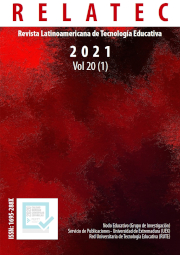Digital competence in the senegalese classroom of spanish as a foreign language
DOI:
https://doi.org/10.17398/1695-288X.20.1.57Keywords:
Digital Competence, Risk of digital exclusion, ELE, Senegal, Digital DivideAbstract
Senegal is a sub-Saharan country that for some years has introduced the teaching of Spanish as LE, however, it has not been able to develop, effectively, due to the technological illiteracy reflected in the digital competence indices. Therefore, this work aims to analyze the digital competence of teachers in the teaching of Spanish in the African country to identify the existing digital divide and how it would increase its risk of digital exclusion. It also tries to propose didactic digital tools, that is, it offers an innovative proposal that promotes the use of new technologies in the didactics of Spanish in Senegal. From the methodological point of view, this is a mixed qualitative-quantitative research based on the Common Framework of Teaching Digital Competence and the questionnaire designed by the University of La Rioja for the analysis of teaching digital competences. As a sample, teachers and students of Spanish with a foreign language from the Gaston Berger University in Senegal have been selected. The results show that there is a disparity in digital skills, which promotes a digital divide and increases their risk of digital exclusion. Therefore, this research aims to contribute to the development of digital competence in Senegalese universities in order to improve the teaching of Spanish and the development of digital skills.
Downloads
References
Cabero Almenara, J. (2004). Reflexiones sobre la brecha digital y la educación. En F.J. Soto & J. Rodríguez (Coords.), Tecnología, educación y diversidad: retos y realidades de la inclusión social (pp. 23-42). Murcia: Consejería de Educación y Cultura.
https://sid.usal.es/idocs/F8/FDO22178/reflexiones.pdf
Cacheiro González, M. L. (2011). Recursos educativos TIC de información, colaboración y aprendizaje. Píxel-Bit. Revista de Medios y Educación, 39, 69-81. https://recyt.fecyt.es/index.php/pixel/article/view/61451
Diouf, A. (2019). Enseñanza-aprendizaje de ELE en los niveles medio y secundario del sistema de enseñanza de Senegal: análisis de los libros de texto y las practicas pedagógicas. Barcelona: Universitat Autónoma de Madrid. doi :10.33881/0123-8264.hop.22106
Dulac, J. (2006). La Pizarra Digital, ¿Una nueva metodología en el aula?. http://www.dulac.es/investigaciones/pizarra/Informe%20final.%20 Web.pdf
Galarza Ramírez, M. (2016). Analfabetismo digital y su incidencia en el proceso de enseñanza – aprendizaje de los estudiantes de la Unidad Educativa Eugenio Espejo del Cantón Babahoyo. Provincia de los Ríos: Tesis-Computation.
http://dspace.utb.edu.ec/handle/49000/3154
García, E. (2010). Materiales Educativos Digitales. Blog Universia. http://formacion.universiablogs.net/2010/02/03/materiales-educativosdigitales/
García-Valcárcel, A. (2016). Recursos digitales para la mejora de la enseñanza y el aprendizaje. Salamanca: Usal Gredos. https://gredos.usal.es/bitstream/handle/10366/131421/Recursos%20digitales.
Gueye, C (2012). Consideraciones generales acerca de la enseñanza y aprendizaje de la lengua española en senegal. Revista el Guiniguada, 21, 47-64.
Gueye, C. (2017). Consideraciones sobre el currículum del español en la enseñanza secundaria senegalesa. Diseño, desarrollo y propuestas de mejor. Qurriculum, 27, 149-160. https://www.ull.es/revistas/index.php/qurriculum/article/view/51
INTEF (2017). Marco Común de Competencia Digital Docente, Ministerio de Educación https://bit.ly/2DUPvHa.
Lázaro, J. O. (2011). La competencia digital docente: ¿qué sabemos y qué podemos hacer? En A. Duque de la Torre, M. Gil Bürman, & C. Sanz de la Morena, C. (2011). Congreso mundial de profesores de español, Instituto Cervantes. Unidad TIC aplicadas a ELE.
Ndiaye, P. W. (2018). El diseño curricular de E/Le en la enseñanza secundaria de Senegal: propuestas de renovación a partir del MCER. http://digibuo.uniovi.es/dspace/bitstream/10651/51294/3
Olarte Encabo, S. (2017). Brecha digital, pobreza y exclusión social. Temas Laborales, 138, 285-313.
Padilla-Hernández, A. L.; Gámiz-Sánchez, M.V. & Romero-López, M.A. (2020). Evolución de la competencia digital docente del profesorado universitario: incidentes críticos a partir de relatos de vida. Educar, 56(1), 109-127. https://doi.org/10.5565/rev/educar.1088
Rodríguez Ramos, D. (2019). Tecnología educativa | Analfabetismo Digital. Ecodiariozapatecas. https://www.ecodiario.com.mx/tecnologia-educativa-analfabetismo-digital/
Tourón, J., Martín, D., Navarro Asensio, E., Pradas, S. e Íñigo, V. (2018). Validación de constructo de un instrumento para medir la competencia digital docente de los profesores Revista Española de Pedagogía, 76(269), 25‑54. doi: https://doi.org/10.22550/REP76‑1‑2018‑02
Unesco (2017). Recursos educativos abiertos. https://es.unesco.org/themes/tic-educacion/rea
Unesco (2020). Urgen alarmantes brechas digitales en el aprendizaje a distancia. https://es.unesco.org/news/surgen-alarmantes-brechas-digitales-aprendizaje-distancia
Unir (2020). ¿Qué es el Marco Común de Competencias Digitales Docentes? https://www.unir.net/educacion/revista/competencia-digital-docente/
Valencia Altamirano, J. C. Topón Gualotuña, D. R. Pérez Fabar, M. A. & Moya, E. J. G (2016). El analfabetismo digital en docentes limita la utilización de los EVEA. Revista Publicando, 3(8), 24-36. https://dialnet.unirioja.es/servlet/articulo?codigo=5833406
Downloads
Published
Issue
Section
License
Authors who publish in this journal accept the following conditions:
1. The Author retains copyright in the article. Upon acceptance of the article, the author shall grant to the Publisher the right of first publication of the article. with the dcoument registered with the Creative Commons Attribution-NonCommercial-NoDerivative 4.0 International (CC BY-NC-ND) license, which allows to third parties to use what is published whenever they mention the authorship of the work and the first publication in this journal.
2. Authors can make other independent and additional contractual agreements for the non-exclusive distribution of the article published in this journal (eg, include it in an institutional repository or publish it in a book) provided they clearly indicate that the work was published for the first time in this journal.
3. Authors are allowed and recommended to publish their work on the Internet (for example on institutional or personal pages) before and during the review and publication process, as it can lead to productive exchanges and a greater and faster diffusion of published work (see The Effect of Open Access).









